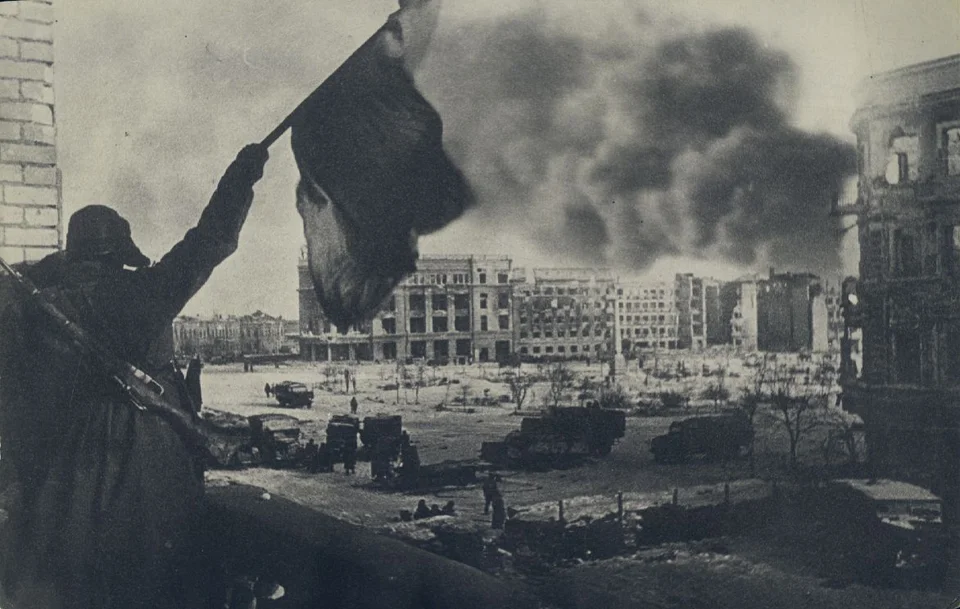By Cain O’Mahony
This year marks the 80th anniversary of the start of the momentous Battle of Stalingrad (23rd August 1942), the costliest battle in human history. It was the clash of the two gigantic dictatorships of Nazi Germany and the Soviet Union, which saw 1.9 million civilians, Red Army and German troops killed, but it was also the turning point of World War II and the beginning of the end for Hitler.
The enormity of the horror at Stalingrad was only added to by the vanity and catastrophic mistakes of both Hitler and Stalin, with the latter victorious despite his previous colossal failures that weakened the Soviet Union’s ability to halt the initial Nazi invasion in the first place.
Stalin had risen to the head of the bureaucracy that ran the Soviet Union, after the smothering of the original ideals of the October 1917 revolution and the purge of the ‘Old Bolsheviks’. The method of the Stalinists was to ‘resolve’ political problems and issues with manoeuvres, organisational twists and turns, expulsions and executions. As the bureaucracy grew in size and strength, so the terror apparatus grew exponentially.
In 1937, Stalin – paranoid that the military hierarchy could overthrow him – promoted the vicious Stalinist apparatchik and editor of Pravda, Mekhlis, to Deputy Defence Commander and unleashed him on a purge of the Red Army.
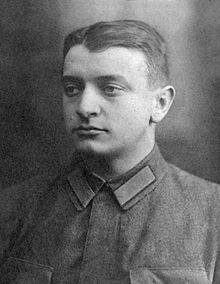
Marshal Tukhachevskii, the Red Army’s creative military thinker and strategist, was the most prominent victim, but the net was cast much wider – three of the Soviet Union’s Marshals were removed, 13 of 15 Army Commanders, eight of nine Admirals, 50 of 57 Army Corps Commanders, 154 out of 186 Division Commanders, 16 of 16 Army Commissars, and 25 of 28 Army Corps Commissars.
Over the next two years, over 30,000 Red Army leaders were discharged from the ranks, while thousands were arrested and executed, or faced torture at the hands of Stalin’s loyal guard dog Lavrenti Beria, head of the Soviet Secret Service, the NKVD (the forerunner to the KGB).
Red Army leadership wiped out
The cream of the leadership of the Red Army had been wiped out. When the Nazis invaded in 1941, the Soviet Union did not even have a military Supreme Command structure in place.
Stalin had also gambled on the Hitler-Stalin Pact in 1939, believing that by signing a non-aggression agreement with Nazi Germany, he could push Hitler into a new war with France and Britain which would, he hoped, see northern France and Belgium once again mired in the stalemate of trench warfare, in a repeat of the 1914-18 conflict, giving him time to rebuild the military structure he had destroyed.
When the Nazi invasion of the Soviet Union came in 1941, Stalin was stupefied: he had a nervous breakdown and retired to his dacha for two days, leaving the country leaderless at this crucial time of crisis, the bureaucrats that surrounded him being too terrified to make a leadership bid.
When Stalin recovered, finally rapidly setting up a Supreme Command structure, the bureaucracy resorted to the only method they knew to stop the collapse of the Soviet Union – yet more terror. On 22 July 1941, in one day alone, four of his Commanders were executed. It was though the Stalinist bureaucracy thought yet another bout of purging the military was the solution:
“So many telegrams flooded in asking permission to shoot traitors, they blocked up the wires in Mekhlis’s office…” (Stalin – the Court of the Red Tsar, Simon Sebag Montefiore).
Needless to say, the leaderless Red Army collapsed. Within the first three weeks of the invasion, the Red Army had lost two million troops, 3,500 tanks and 6,000 aircraft, and the German tanks rolled all the way up to the gates of Leningrad and Moscow itself.

But Hitler had miscalculated too, and had underestimated the fury of the Soviet masses, and the advantages of a planned economy, albeit one groaning under the weight of an overriding bureaucracy.
Fight or be enslaved or exterminated
Hitler had made no secret of his purpose to invade eastwards: he wanted to create ‘lebensraum’ for his new empire, with plantations of ethnic Germans while any surviving Soviet peoples would be reduced to mere vassals to serve their German masters. For the Soviet masses meanwhile, despite the terror of the bureaucracy, there were still many gains from the October revolution, whether in employment, education, housing, health services etc that were still worth defending. The choice was simple – fight to defend those remaining gains of October, or be enslaved or exterminated.
Equally, as Germany become more embattled, its economy could never compete with the Soviet Union. The Soviet Union was still a planned economy – the Stalinist bureaucracy had no independent position in the process of production, no independent ownership or property roots; they were a parasitic outgrowth privileged in consumption, rather than in ownership of the means of production. The State had taken over industry and had kept control of it – rather than individual bureaucrats – and this fundamental step towards socialism ensured it remained a “workers’ state”, albeit a deformed and degenerated one, but one where you could still plan the economy, especially in this time of war.
In a Herculean effort, arms producing factories were moved to the Urals, out of range of Nazi bombers (unlike Germany which was increasingly being battered by the RAF and later the USAF). Equally, when the Soviets fell upon an effective weapons system – such as the highly successful T34 tank, the AK47 machine gun or the ‘Shturmovik’ attack aircraft – it went into mass production, rather than seeing time wasted by private companies competing with each other in the pursuit of favourable profit margins, as under capitalism.
This was graphically illustrated by tank production. Nazi Germany still rested on a capitalist economic model: the giant corporations that bankrolled Hitler were now rewarded with monopolies for the profitable war work, and for many the cheapest form of labour: slaves. The four main companies producing tanks – MAN, Daimler-Benz, Rheinmetall-Borsig and of course Krupp – produced, throughout the war, 24,260 tanks. By comparison, the Soviet Union produced 58,000 T34s alone. By 1944, Germany was producing only 104 Tiger Tanks a month, compared to the Soviet Union’s 1,300 T34s a month.
Also, those German tanks produced by the different companies were all of different shapes, sizes, engine parts, guns etc. The T34 on the other hand was universal – 60 per cent of the Red Army’s Armoured Fighting Vehicles were T34s, meaning compatible ammunition, spares and so on, minimizing logistical supply problems, that the Nazis faced as they drove further and further from Germany. Hitler was never going to win.
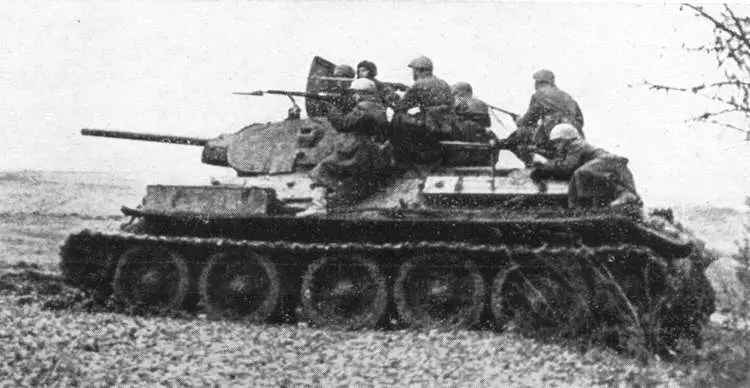
It did not seem like that to Hitler in 1942 however. His armies on the south of the Eastern Front were sweeping south towards the Caucasus with the prize of Baku in their sights. Baku produced 80 per cent of the Soviet Union’s oil supplies, without which the Soviet Union would face collapse, while Nazi Germany would gain a much-needed fuel source.
Hitler’s error
But Hitler was tempted by the propaganda prize of capturing the city that bore the name of his rival, particularly after his failure to take Leningrad and Moscow. Against the advice of his Generals, Hitler split off the German VI Army from his three southern forces and sent them to take Stalingrad. The city did have some strategic value, but nothing in comparison to Baku.
In Hitler’s mind, Stalingrad was the ‘most communist of cities’, and issued orders that when the city was taken, all boys and men were to be executed, and all girls and women were to be sent to labour camps. The people of Stalingrad had little choice but to fight – or die.
As catastrophe approached, Stalin still meddled. He insisted on a counter-offensive against Kharkov, despite the Commissar for the Stalingrad region, Khrushchev, and General Timoshenko pleading with him to call it off, as failure would leave Stalingrad exposed. As predicted, the misjudged Kharkov offensive was a disaster for the Red Army, allowing the Germans to enter Stalingrad on 12 September, after pulverizing it with bombardment from both land and air.
The German VI Army under General Paulus took the city, but the Red Army’s 62nd Army under General Chuikov grimly held onto the west bank of the Volga, creating a foothold for the Red Army to rebuild its forces.
The city had prepared. It was not evacuated, but employed every citizen to fight total war. The historic Order No.227: ‘Ni Shagu Nazad’ – not one step backwards – was issued. Those not needed for the remaining war work (the city’s tank factory continued to produce T34s, many joining the battle unpainted, straight from the factory) were recruited to a Workers Militia.
Women in the Red Army
As was happening throughout the Soviet Union as it scrambled to replenish the Red Army ranks after the earlier massive losses, women were joining the Red Army in their thousands.
Stalingrad was no exception, and eventually 60 per cent of all anti-aircraft batteries were manned by women. General Chuikov said: “Anyone who visited the front would see women acting as gunners in anti-aircraft artillery units, as pilots of aeroplanes doing battle with the German air aces, as captains of armoured boats in the Volga fleet, for example, carrying cargoes from the left bank to the right and back again in unbelievably difficult conditions. It is no exaggeration to say that women fought alongside men everywhere in the war” (The Battle for Stalingrad, Marshal Chuikov).
The most famous of the women fighters was the 1077th Anti-aircraft Regiment, which was made up entirely of young women volunteers, barely out of high school. At one point during the fighting around the ‘Tractor Factory’ area, they set their AA guns to the lowest elevation, firing point blank at an advancing Panzer column.
The destruction the Germans had wrought on the city worked to the Red Army’s advantage. The streets were now filled with rubble, so the Germans could not use their tanks and armoured vehicles – their main advantage – effectively. It became a war of small arms. Before the war, Red Army strategists had studied the street fighting tactics used during the Spanish Civil War, in particular those in the battle around University City in Madrid in December 1936, and had seen the advantage of making large, sturdy buildings into strongholds (World War II, Lt Col Eddy Bauer).
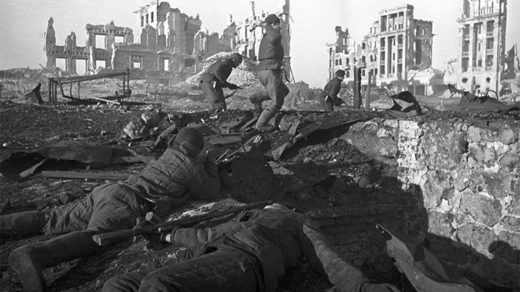
Chuikov said the Red Army’s resistance “…did not depend on strength, but on ability, skill, daring, guile. Buildings split up enemy formations like breakwaters, forcing them to follow the lines of the streets. That is why we clung to the most solid ones, with small units capable of all round defence.”
Soon such citadels sprung up around the devastation, whether the Tractor Factory, the Elevator or ‘Pavlov’s House’, a housing complex where from the end of September, a small unit led by Sgt Pavlov tied the Germans down for 58 days.
Importance of morale
Just as important for any fighting force as weaponry and tactics, was morale. The Communist Party had maintained its Party Cell structure in every military unit. These were not directed by some party bureaucrat lecturing from afar. You were not accepted into a military Party Cell until you had been in combat, and even then, only if you had displayed ‘solid military qualities.’ The Party Cells held educational meetings, rallies, and produced newsletters and leaflets, ‘even in the cellars of Stalingrad’. Before a major action, they would hold meetings to explain why it was taking place and the importance of the action to the wider situation in the Soviet Union.
The Party Cells also made permanent links with the home front in a sort of ‘town twinning’ arrangement: each military unit would be adopted by a town, factory or collective farm, with news, reports and letters passed between the two. Indeed, letters from individuals on the Home Front to the soldiers were comforting and encouraging, particularly for those soldiers from western Soviet Union who had lost their families to the Nazi slaughter.
The same cannot be said for the German forces, where strict hierarchies were maintained, while of Germany’s 76 Divisions in the Stalingrad salient, 18 were Romanian, 9 Hungarian and 9 Italian, all mainly conscripts, unhappy to have been forced to fight in another country’s ‘crusade against Bolshevism’.
The battle would rage for six months. The casualties were appalling. The Red Army’s 13th Guards Division for example, suffered 80 per cent casualties in just one week. Of the 10,000 Red Army troops originally in the city when the Germans attacked, only 320 survived the whole battle.
It brutalised both sides. Top Soviet sniper Anatoly Chekhov described the first time he shot someone: “I felt terrible. I had killed a human being.” But after just a few weeks of the bitter fighting, he said: “I started to mercilessly fire on them. I’ve become a barbaric person, I kill them. I hate them.”
Marshall Zhukov
The task of retaking Stalingrad fell to Georgy Zhukov. This brilliant (but brutal) military strategist had a reputation for standing up to Stalin. This was mainly because he had achieved hero status in the Soviet Union by winning a decisive battle against the Japanese at Khalkhin Gol in 1939. However, he knew he was never entirely safe. During the initial German invasion, he urged Stalin to retreat the Red Army from Kiev only for Stalin to dismiss him as Chief of Staff and send him to the frontline.
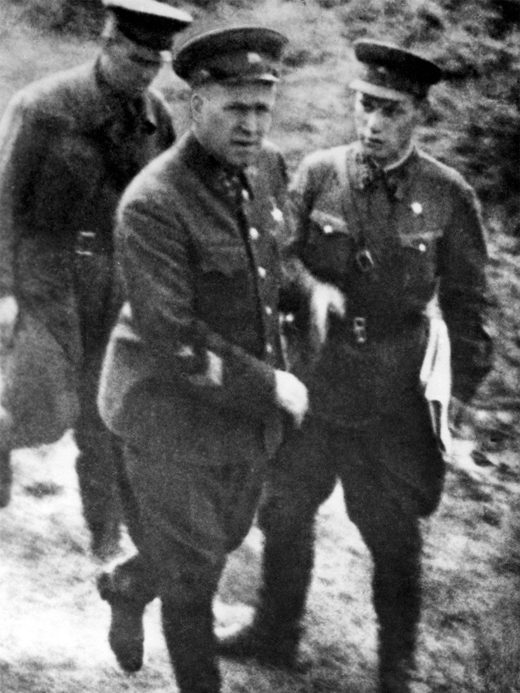
Recalled to the Kremlin as calamity mounted, Zhukov and his Generals still knew the dangers. He recalled in his memoirs: “We could remember 1937. If anything went wrong, they knew they’d end up in Beria’s hands and Beria was always there during my meetings with Stalin.” Indeed, one of Zhukov’s staff, General Rokossovsky, still bore the scars from his time in Beria’s torture chambers in 1937.
But on 9 October, for once Stalin did something right. On his direction, the Praesidium of the Supreme Soviet dissolved the ‘Corps of Political Commissars’ and handed back control of the battle to Zhukov and his generals. It is true Stalin was probably hedging his bets, in that it would be Zhukov that faced blame and disgrace if the city fell to the Nazis. But at least they were free of Stalin’s interference.
Hitler on the other hand still clung to his vainglorious belief that he was a military genius, overruling his Generals with a series of disastrous decisions that plagued the German forces all the way to the fall of Berlin. Stalin had followed the same course up until 9 October, but his decision for once to leave the Red Army free of the dead hand of the bureaucracy changed the course of history.
His hands untied, Zhukov began the planning for Operation Uranus. He planned a three-pronged attack led by General’s Yeremenko, Rokossovsky and Vatutin, to encircle the German VI Army.
The offensive was launched on 19 November, and the Germans were pounded by 13,500 guns and bombed by 1,100 aircraft, and attacked by a Red Army force of one million troops and 1,400 tanks.
Unbearable and unsustainable
Paulus’s VI Army was soon encircled and conditions in Stalingrad became both unbearable and unsustainable. Hitler’s Air Marshal, Goering, boasted he would keep the VI Army supplied with an ‘air bridge’, with the Luftwaffe dropping supplies to the embattled Germans.
As was becoming increasingly the case, Goering’s deeds did not match his boasts. The air bridge failed – Paulus needed 680 tons of supplies per day, but even on a ‘good’ day, only 100 tons arrived. By December, the rations of the German troops were 200 grammes of bread and one bowl of soup per day, if they were lucky. Many died of starvation. Resistance finally collapsed on 30 January 1943, and Paulus surrendered the remnants of his army. Of the 330,000 German troops that had invaded the city, only 91,000 survived. Of them, only 6,000 ever returned to Germany.
The victory of the Red Army at Stalingrad sent a boost to morale throughout both the soldiers and civilians of the Allies. In Britain, Coventry – devastated in 1940 – even took a leaf out of the Red Army Party Cell book and formally twinned itself with Stalingrad, the first ‘town twinning’ in history. A chink of light had appeared at the end of the tunnel.
Yet both dictators developed amnesia over Stalingrad, one – not surprisingly – very quickly, the other in the long term.
The Nazis were dumbstruck for four days on how to present the massive defeat, which everyone knew was the beginning of the end. They chose to portray it as some Wagnerian epic, a heroic sacrifice that had to be made for the greater goal of coming victory. The Nazis eventually reported it to the people on 3 February. Goering, in his address at a rally celebrating the anniversary of the Nazis taking power, declared: “Even in a thousand years every German will speak of this battle with religious awe and reverence and know that, despite everything, Germany’s victory was decided there.”
Cynicism
On the home front, previous fervour was turning to cynicism. The Gestapo, in their surveillance of the civilian population, reported a disturbing little ditty doing the rounds on the streets and in the factories, parodying the Nazi’s hollow propaganda:
First year of the war: we have won
Second year of the war: we shall win
Third year of the war: we must win
Fourth year of the war: we cannot be defeated
(The German War, Nicholas Stargardt)
Far from the memory lasting a ‘thousand years’, the Nazis ‘forgot’ about Stalingrad by the next month. Hitler, in a national radio broadcast to the German people on 21 March 1943 to mark ‘Heroes Memorial Day’, did not mention Stalingrad once.
Stalin took some time longer. To celebrate the victory, he set up the ‘Commission on the History of the Great Patriotic War’, and the Soviet Union’s top historians were dispatched to all the fronts to interview frontline soldiers on their experiences. At the same time, Stalin re-introduced epaulets to uniforms, in the style of the old Russian Imperial Army.
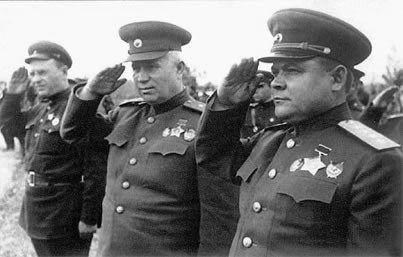
The latter did not go down well with the more left-wing sections of the Red Army:
“A secret NKVD report from the Don Front noted that some soldiers wondered why the army campaigned against the golden shoulder pieces only to reinstate them with great ceremony; others sensed the pressure of the Soviet Union’s Western allies and feared that the Red Army would devolve into a ‘bourgeois capitalist’ military force”
(Stalingrad: The City that Defeated the Third Reich, Jochen Hellbeck).
Dissenting voices
It can only be assumed there were similar dissenting voices in the interviews carried out by the Commission, as well as more praise for Marshal Zhukov and his Generals, than for Stalin. When the Commission completed its work after victory in 1945, the vast majority of their colossal piece of work was destroyed and the historians threatened with arrest if they ever revealed its contents. Stalin hadn’t liked what he had seen.
Nor did he enjoy the 1945 Victory Parade in Moscow, where it was Marshal Zhukov – resplendent on a white charger – who received the adulation of the mass crowds, not Stalin. Zhukov was suddenly accused of ‘Bonapartism’ and reduced in rank to a mere military district leader in faraway Odessa, on the Black Sea coast.
Following the death of Stalin in 1953, the Soviet Union would remain a Stalinist state. But at least the Generals had some revenge for 1937, now that Stalin’s deathly grip had loosened. Beria had assumed control, but Marshal Zhukov launched a coup. A tank regiment backed by infantry occupied Moscow to nullify Beria’s NKVD. The Marshal and his Generals then marched into a Politbureau meeting and arrested Beria. He was unceremoniously bundled out into a barn, and shot. They installed Krushchev in his place, and the position of Premier and First Secretary of the Soviet Union was now occupied by the former Commissar for Stalingrad.

